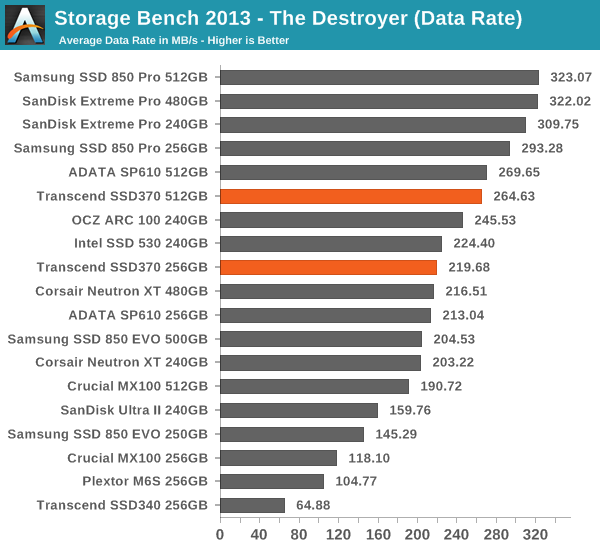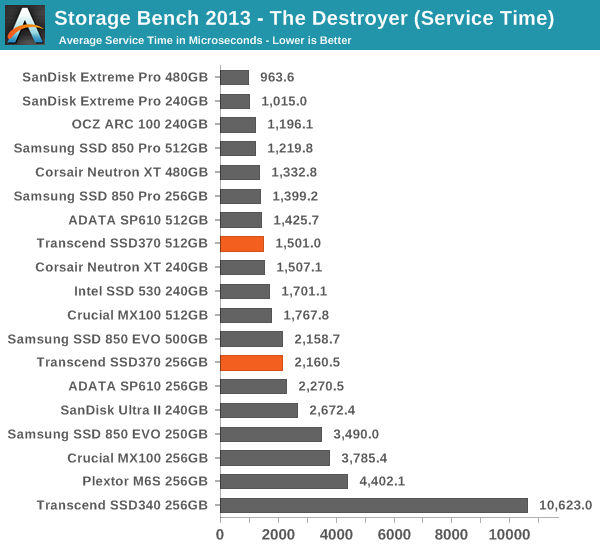Transcend SSD370 (128GB, 256GB & 512GB) Review
by Kristian Vättö on January 27, 2015 8:00 AM EST- Posted in
- Storage
- SSDs
- Transcend
- Silicon Motion
- SM2246EN
AnandTech Storage Bench 2013
Our Storage Bench 2013 focuses on worst-case multitasking and IO consistency. Similar to our earlier Storage Benches, the test is still application trace based – we record all IO requests made to a test system and play them back on the drive we are testing and run statistical analysis on the drive's responses. There are 49.8 million IO operations in total with 1583.0GB of reads and 875.6GB of writes. I'm not including the full description of the test for better readability, so make sure to read our Storage Bench 2013 introduction for the full details.
| AnandTech Storage Bench 2013 - The Destroyer | ||
| Workload | Description | Applications Used |
| Photo Sync/Editing | Import images, edit, export | Adobe Photoshop CS6, Adobe Lightroom 4, Dropbox |
| Gaming | Download/install games, play games | Steam, Deus Ex, Skyrim, Starcraft 2, BioShock Infinite |
| Virtualization | Run/manage VM, use general apps inside VM | VirtualBox |
| General Productivity | Browse the web, manage local email, copy files, encrypt/decrypt files, backup system, download content, virus/malware scan | Chrome, IE10, Outlook, Windows 8, AxCrypt, uTorrent, AdAware |
| Video Playback | Copy and watch movies | Windows 8 |
| Application Development | Compile projects, check out code, download code samples | Visual Studio 2012 |
We are reporting two primary metrics with the Destroyer: average data rate in MB/s and average service time in microseconds. The former gives you an idea of the throughput of the drive during the time that it was running the test workload. This can be a very good indication of overall performance. What average data rate doesn't do a good job of is taking into account response time of very bursty (read: high queue depth) IO. By reporting average service time we heavily weigh latency for queued IOs. You'll note that this is a metric we have been reporting in our enterprise benchmarks for a while now. With the client tests maturing, the time was right for a little convergence.

What surprises me is that the SSD370 does so well in the 2013 Storage Bench even though its IO consistency is leaves a lot to be desired. Again the performance is a very close match with the SP610 and overall the SSD370 is a fairly capable middle-class performer.











44 Comments
View All Comments
danwat1234 - Saturday, January 21, 2017 - link
Might not have been the flash degration, perhaps some other failure. A couple hundred TB before real failure probably. At least 100 I would say. Google this thread "SSD Write Endurance 25nm Vs 34nm" - has extreme testing to failure. But yeah, your SSDs were probably sub 25nm.nathanddrews - Tuesday, January 27, 2015 - link
Has AT ever done anything beyond testing TRIM and provisioning? Are you talking about prolonged write endurance? I think the manufacturer states that. Or are you thinking of this?http://techreport.com/review/27062/the-ssd-enduran...
Solid State Brain - Tuesday, January 27, 2015 - link
The quoted numbers are what one would normally expect from honest SSD manufacturers who take into account actual 2x nm MLC NAND endurance with random workloads, based on a 3000 P/E cycles threshold. It's really nice that Transcend doesn't just settle with "40 GB/day" or "80 GB/day" or similar figures just because most consumers won't ever write that much daily.Dr0id - Tuesday, January 27, 2015 - link
Do you know plan on reviewing the Muskin Enhanced Reactor series? The 1 TB model seems to be the least expensive model on Newegg for that capacity.Kristian Vättö - Tuesday, January 27, 2015 - link
That's the next drive in the queue, so check back next week :)hojnikb - Tuesday, January 27, 2015 - link
Give some love to the newfly released BX100 (based on the same controller). Looks like a nice budget offering from Crucial that happens to have very high random io for that controller.Kristian Vättö - Tuesday, January 27, 2015 - link
I don't have samples yet.romrunning - Tuesday, January 27, 2015 - link
In most of the tests, the Crucial MX100 beats the Transcend SSD370 at the same capacity. The Crucial drives are also cheaper by a few bucks. If that's the case, then why is it said that the Transcend drives are undercutting their competitors? Also, how can you draw the conclusion that the Transcend is the best value drive - better than the MX100?hojnikb - Tuesday, January 27, 2015 - link
Because it kills every crucial offering in mixed workload (destroyer).Sequential speeds mean very little with ssds.
Don Tonino - Tuesday, January 27, 2015 - link
How do mixed workload correlate with the random write/read results? I've seen the same behaviour in another reviews, where the aggregate results of the SSD370 are shown to be much better than the MX100, notwithstanding both sequential and random results being much better on the latter.As I'm debating which SSD to buy to use as storage for my Steam library, I'd be interested in better understanding how to tell which one of the two is better suited.